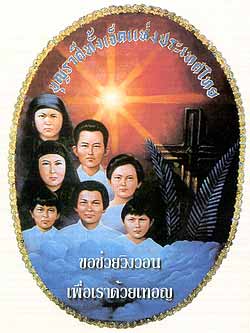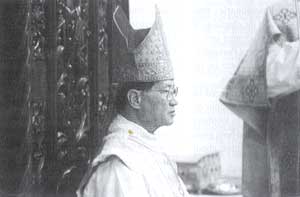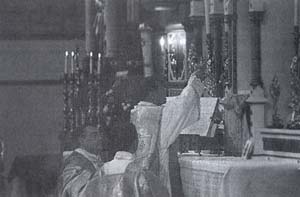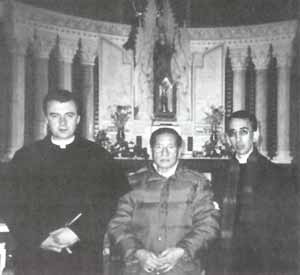

![]()
![]()
|
Newsletter of the District of Asia Oct - Dec 2002 Editorial
The Kingdom of Thailand, known as the Land of Smiles, lies in the heart of Southeast Asia, roughly equidistant between India and China. Thailand is approximately the size of France and has a population of around 62 million. Thailand is 94% Theravada Buddhist with only 265,000 Catholics—a Catholic for every 240 Buddhists. It is the only country in Southeast Asia that has never been conquered and occupied by a foreign power since the foundation of the first Thai kingdom in 1238. Thailand is has been governed by a constitutional monarch since 1932, and it does not take long to see how the Thais love and respect their present King, H.M. Bhumipol (Rama IX). Large and richly ornate framed photos of him are displayed at traffic junctions, at round-abouts, along highways. Thai Airways even celebrated his birthday on their aircraft. The present King has been in power since 1946! The stability of the monarch has certainly been a source of strength against the endeavors of the Communists to infiltrate the land. Unfortunately, he has not been able to curb the corruption, prostitution of all kind, for which, Bangkok in particular, is infamous. King Bhumipol is one of the surprisingly numerous Asian rulers - for instance the Empress of Japan, the President of Sri Lanka, and the late King of Nepal - who were educated in Catholic schools in their youth, at a time when Catholic schools towered over other teaching institutions.. He studied under the St Gabriel Brothers. In the following pages, we have put together some articles to give our readers an idea of the history of the Catholic missionary life in this relatively peaceful country (see A Brief History Of The Catholic Church In Thailand). There are no canonized Saints, yet, in Thailand. However, a group of Seven Blessed Martyrs, and another martyred priest, Blessed Father Nicolas, were beatified in the late 1997. In fact, the very first missionaries who reached the Thai shore, two Dominican priests, were martyred in 1567, in the peninsula. The story of the Seven Blessed Martyrs of Thailand is given as a Christmas story, since they were martyred on December 26, 1940. It is a story which resembles in its beautiful simplicity the story of the early Martyrs of the Church. The faith of such Martyrs, recently proposed to us as models by the Church contrasts terribly with, or should we say contradicts, the new Conciliar spirit which has unfortunately also reach these shores. In another article we give some extracts of an interview with the secretary of the Thai Bishops’ Catholic Commission for Liturgy. Inculturation at any cost is the order of the day. Even at the cost of the Faith - and therefore ultimately of the eternal salvation for has not St Paul written, “Without faith it is impossible to please God” (Heb. 11.6). This inculturation at any cost, particularly in liturgical matters - the intravenous drip by which all the Conciliar spirit reaches the people - shows a total misunderstanding of the liturgy. Liturgy is the official prayer of the Catholic Church, to give God the worship which is due to Him. Every country has official ceremonies, official protocols for official functions, and all of these are in the country’s official language. The Liturgy is that official, or public, adoration given to God by the Roman Catholic Church, by the explicit order, command of Our Lord Jesus Christ. “Do this for a commemoration of Me!” The 1917 Code of Canon Law said: “If worship is offered in the name of the Church by persons lawfully deputed for this function and through acts which, by institution of the Church are to be offered only to God, and the saints and blessed, the worship is public; otherwise it is private.” (c. 1256) And the following canon added: “It pertains exclusively to the Holy See to control the sacred Liturgy and to approve liturgical books.” (c.1257) When a priest offers the Holy Mass or says his breviary, he does it by the mandate of the Church, in the name of the whole 2000 year-old Catholic Church, triumphant, suffering, and militant. The celebration of the Mass is a public prayer as is the recitation of the Divine Office, whether there are 1000 or only one faithful attending Mass or the Divine Office is said by the priest alone or by a dozen. That is one reason why the Holy Mass and the Divine Office are so powerful. When the same priest says his rosary or prays the Stations of the Cross, since these are not parts of the liturgy, he prays them as private prayers, in his own name. Which is quite a big difference. This distinction between private and public prayer is of utmost importance in order to understand the Liturgy in itself, and to see how truly un-liturgical is the conciliar liturgical reforms, which introduced creativity in the liturgy, or in other words, which reduced the public prayer of the Church to the personal moods of the celebrant. Of course this monopoly of the pre-Vatican II Liturgy by Rome (as in canon 1257) has now been dismantled in favor of Bishops’ Conferences. This was perhaps the one single change which has had the most dramatic consequences in all the Liturgical Reform. The most important, key text of Vatican II on this issue, is in its Constitution on the Liturgy:
The result has been a real ‘privatization’ of the Liturgy, therefore its destruction as a common, public prayer of the universal Church, and, as a necessary outcome, a de-Catholicization of the Liturgy. The Liturgy has now lost its Catholic note. It is no longer universal. It is a local issue, not even a national one, as it may change from parish to parish, from dialect to dialect, from tribe to tribe, within the same country. The Liturgy has also lost its note of Unity. The concept of “unity in diversity” is very deceiving. Imagine a group of people of different languages all speaking in their own tongue at the same time in the same place. That would be real cacophony. Compare that then with the same crowd singing in the Church’s Latin a Credo, or a Salve Regina. That is the unity in diversity that the Church has had for centuries. Before the arrival of the New Mass, you could travel in most of the world and find the unique Roman Rite of the Holy Sacrifice of the Mass, as it was at home, in your own parish church. With inculturation , the Liturgy has also lost its note of Apostolicity. The beautiful prayers of the Traditional Roman Rite embody the whole history of the Church in them, the history of the Apostolic beginnings, of the persecutions, of the heresies, of the Councils. And finally, as it may be perhaps the most obvious, the reverence, the heavenly Sanctity of the Holy Mass has given way to a ‘human’ celebration, adapting any local element in the supreme act worship due to God. Last August, to give a fresh example, during the ceremony of canonization of Blessed Juan Diego, the privileged seer of our Lady of Guadalupe, in Mexico, Aztec dances and rituals were held during the Mass. What an irony, when one thinks that Our Lady of Guadalupe came to free the Mexican from this incredibly blood-thirsty pagan religion. When Churchmen dare say that people did not know how to pray before the liturgical reforms of Vatican II, before this inculturation, that they did not know the meaning of the Holy Mass, such statements are truly scandalous and insulting for centuries of devout Catholic and hundreds of thousands of martyrs who certainly knew what their faith was, and what they were dying for. Here is an example of the consequences of leaving the liturgy in the hands of any Episcopal Tom, Dick and Harry. When asked, last July 2002, what the Thai Liturgical Commission was doing to improve the liturgy, one Thai Bishop, Bishop Joachim Phayao Manisap, replied:
This echoes very well another episcopal ‘pearl’ which shows how far one can go in this real revolution of the notion of mission. The following text concerns this time the Amazon Indians, in Brazil. One can simply replace ‘Indian’ by any local tribe’s name.
Incredibly, this text goes back to 1972! It is found in the Pastoral Plan of the Bishops of the Amazon, in ‘O Estrado de São Paolo’, May 26, 1972. One of the Asian liturgical experts understood this very well when he said, “Liturgical renewal requires predominantly a cultural integration of the space and materials used for the liturgy instead of only the texts, rites and symbols. This,” he said, “can be achieved through some adjustments with local culture.” He noted that for “many Asian Catholics, the official liturgy is no less than a strange ceremony which does not touch their hearts.” (Father Ramon Fred C. Ofredo, at the July 20-24,2002, Fifth Asian Liturgy Forum-South East Asian Region in Denpasar, Bali.) This writer had recently a very opposite experience. Last August 15, in La Vang, the National Marian Shrine of Vietnam, 200,000 faithful were gathered to honor the Mother of God. Rome had allowed them to have the liturgy either in Vietnamese or if they wished so, even in Latin. Well, for the whole three day pilgrimage the only Latin that I heard was Gounod’s and Lourdes’ Ave Maria, and played on the speakers. About a dozen Bishops were there with hundreds of priests. Latin — Rome said yes, the local clergy said no. Three days later, I visited a mountain village in the Central Highlands, and heard 800 natives, the minorities as they are called there, sing the Missa de Angelis, on an ordinary Sunday morning. The day before I had met some members of the choir who sang - by heart and wholeheartedly if you please - for me the Salve Regina, Puer natus est, Pueri Hebraeorum, Regina Coeli and a few other pieces of the Gregorian repertoire. These people have no need to adjust the liturgy to their local culture, they love it as it is. Unfortunately, as it is the case most frequently, it is the clergy who imposes - literally - the changes, instead of simply explaining the liturgy to their people. As we are speaking of Thailand, many of our readers have heard of Bishop John Bosco Manat, the good friend of Bishop Lazo. Read his conference given in Winona in February 2001, and published in the November 2001 Angelus. At this moment, there is also one young Thai lady who has joined our Bethanians, in Manila, and is working on her French before choosing her future Congregation.
Bishop
Manat offering his first Traditional Pontifical Mass
Bishop
Manat visiting the Shrine of St. Anne de Beaupre, Québec,
on February 8, 2002.
More on Asian vocations: as I am writing these lines, four Indian young men, have just transited through Singapore and are now in the plane on their way to Australia to enter Holy Cross Seminary. They have spent a good six months with our priests in Southern India and, thanks be to God and to St Rita’s intercession, got their Australian visa. Another young Filipino should join them soon. December 3, 2002 is the 450th anniversary of the death of St Francis Xavier off the Chinese coast on the island of Sancian near Hong Kong. We give after the Dossier on Thailand, the account of his lonely death and his burial. Last year, I was fortunate to visit the island and pray there for all our friends and benefactors. A blessed Advent-tide to all, as well as a truly spiritual Christmas, filled with an increased knowledge of our Divine Savior, the only hope of our sinking world.
|




